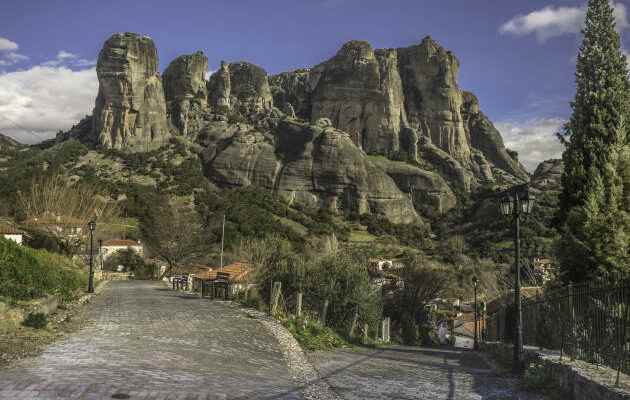The first time is under a fiery red sky, at dusk: the Meteors appear at the end of the road, shortly before Kalambaka. The closer you get to them, the more they multiply. “They” are the cliffs. Cinematic cliffs, in the middle of nowhere, lit by the neon lights of a hotel sign welcoming tour-operator clients. It feels like a Wim Wenders movie; just missing the music of Ry Cooder. The second time, it’s in the early morning, still in Kalambaka, when they reappear at the bend of an alley or a square, to disappear in a game of hide and seek. So much for the decor. A spectacular, almost unreal landscape.
The Meteors are revealed and tamed provided you take your time. This luxury is even recommended if one wishes to understand their aerial and celestial magic. A landscape born from the waters, 200 to 300 million years ago, when the sea covered the great plain of Thessaly. The sea has disappeared, and erosion over the millennia has sculpted these vertical limestone giants, more prettily called “puddingstones”. A superposition of strata that can be guessed from afar. A conglomerate made up of pebbles connected by a sandy cement.
Between heaven and earth
Up close, it looks like a shortbread. Except that it is of an improbable hardness. The pebbles, the size of an olive or a watermelon, are stuck together by a kind of concrete. In the sun, these millennial sediments sparkle. The shape is dizzying: walls over 600 meters high, towers between heaven and earth that attract climbers, Meteora being a famous spot for climbing.
A beauty that has not escaped the anchorites, contemplative religious, first to settle in the caves and cavities of these places, in the XIe century. It is to Athanasius of Meteora, who had a vision of hanging rocks from afar, that we owe their name and the construction of the first monastery, that of Great Meteora, around 1350. Of the twenty-four buildings erected between the XIVe and XVIe centuries, only six remain.
These eagle’s nests merge with the rock, an illusion skilfully maintained by their builders. “I really like the monastery of Saint Nicholas, it is small and has beautiful frescoes. That of the Sainte-Trinité is also magnificent, there are few groups because you have to climb stairs! »confides the tourist guide Lina Karakatsani, before explaining that the ruins of the old religious buildings draw the domes and the cliffs of the rocky peaks.
You have 67.8% of this article left to read. The following is for subscribers only.
